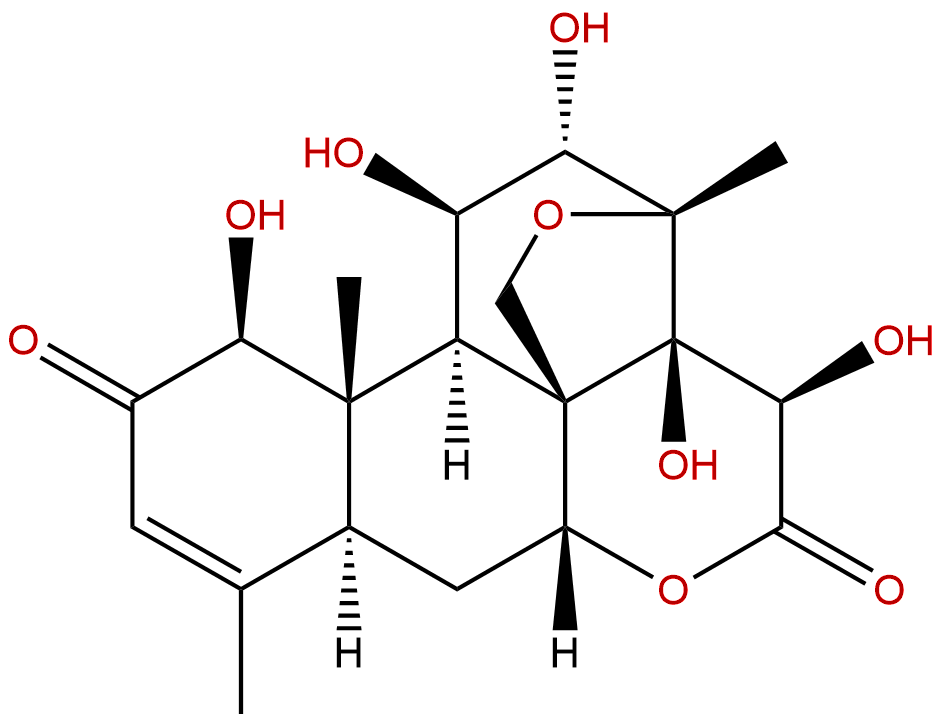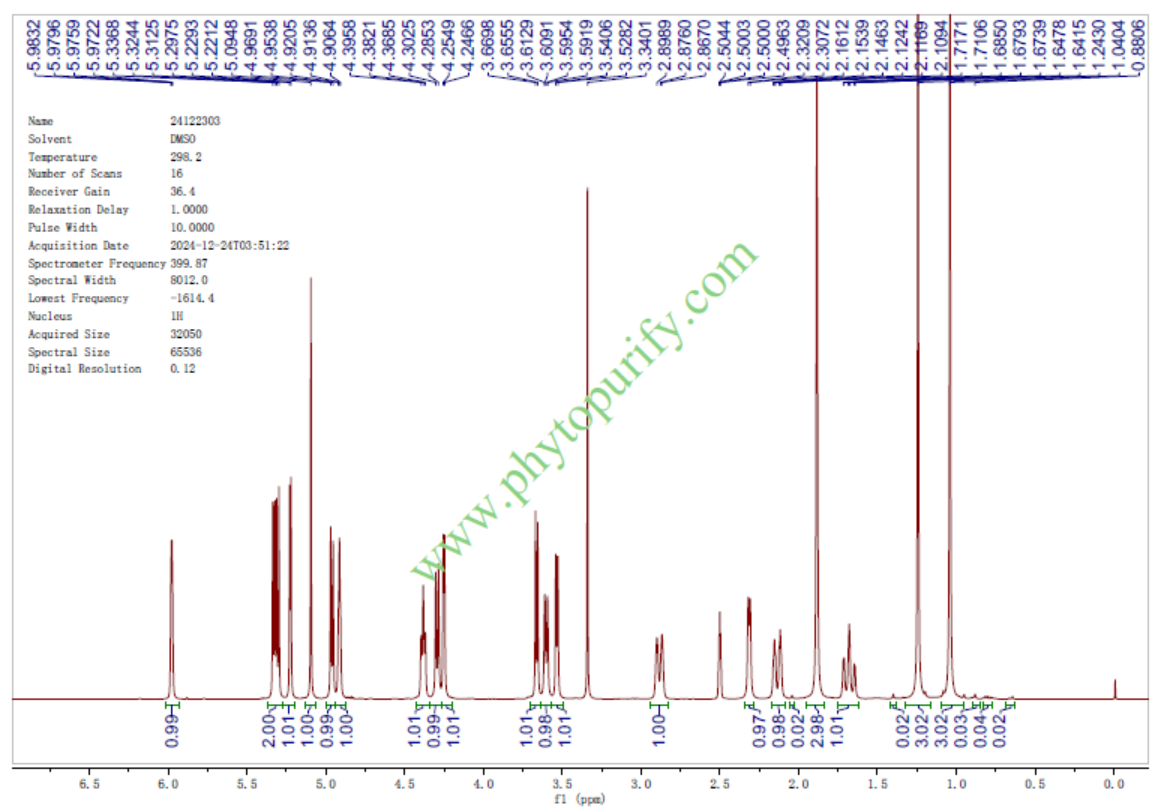
Bruceine DCAS No.:21499-66-1
|
||||||||||
 |
|
|
||||||||

| Catalogue No.: | BP3461 |
| Formula: | C20H26O9 |
| Mol Weight: | 410.419 |
Product name: Bruceine D
Synonym name: Brucein D
Catalogue No.: BPF0771
Cas No.: 21499-66-1
Formula:C20H26O9
Mol Weight: 410.42
Botanical Source:
Physical Description: Powder
Type of Compound: Diterpenoids
Purity: 95%~99%
Analysis Method: HPLC-DAD or/and HPLC-ELSD
Identification Method: Mass, NMR
Packing: Brown vial or HDPE plastic bottle
The product could be supplied from milligrams to grams. Inquire for bulk scale.
We provide solution to improve the water-solubility of compounds, thereby facilitating the variety of activity tests and clinic uses.
For Reference Standard and R&D, Not for Human Use Directly.
Description:
Bruceine D has anti-cancer activity, it inhibits the growth of three pancreatic cancer cell lines, i.e., PANC-1, SW1990 and CAPAN-1; induces cytotoxicity in Capan-2 cells via the induction of cellular apoptosis involving the mitochondrial pathway.Bruceine D may have the potential to be used as a natural viricide, or a lead compound for new viricides.
References:
Int J Mol Med. 2012 Jul;30(1):93-9.
Involvement of the mitochondrial pathway in bruceine D-induced apoptosis in Capan-2 human pancreatic adenocarcinoma cells.
Our research group has previously identified Bruceine D (BD), a quassinoid found abundantly in B. javanica, to have potent cytotoxic effect on a number of pancreatic cancer cell lines, including Panc-1, SW1990 and Capan-1 cells.
METHODS AND RESULTS:
In the present study, we showed that Bruceine D was also able to inhibit the growth of the Capan-2 human pancreatic adenocarcinoma cell line, but it exerted only modest cytotoxicity on the WRL68 human hepatocyte cell line and a human pancreatic progenitor cell line. The antiproliferative effects of Bruceine D were comparable to those exhibited by camptothecin and gemcitabine in our culture system. We found a dose-dependent decrease of the mitochondrial membrane potential in Bruceine D-treated Capan-2 cells as measured by the JC-1 assay. Bruceine D exposure was able to attenuate the expression of Bcl-2 protein in Capan-2 cells as detected by western blot analysis. In addition, the expression of both caspase 9 and caspase 3 in Bruceine D-treated Capan-2 cells was significantly accentuated. Moreover, Bruceine D was capable of inducing the fragmentation of genomic DNA in Capan-2 cells as evidenced by Hoechst staining. Cell cycle analysis demonstrated that Bruceine D could increase the percentage of Capan-2 cells in the subG1 phase in a dose-related manner. An increase in the apoptosis of Capan-2 cells was also observed by Annexin V and PI staining.
CONCLUSIONS:
These results unequivocally indicate that Bruceine D induces cytotoxicity in Capan-2 cells via the induction of cellular apoptosis involving the mitochondrial pathway.
Vet Parasitol. 2011 Apr 19;177(1-2):127-33.
In vivo anthelmintic activity of bruceine A and bruceine D from Brucea javanica against Dactylogyrus intermedius (Monogenea) in goldfish (Carassius auratus).
The present study was designated to ascertain the anthelmintic activity of the dried fruits of Brucea javanica and to isolate and characterise the active constituents. The methanol extract from the fruits of B. javanica showed significant anthelmintic activity against Dactylogyrus intermedius (EC(50) (median effective concentration) value=49.96 mg l(-1)).
METHODS AND RESULTS:
Based on this finding, the methanol extract was fractionated on silica gel column chromatography in a bioassay-guided fractionation affording two known quassinoids showing potent activity, bruceine A and Bruceine D. Both bruceine A and D exhibited significant activity against D. intermedius with EC(50) values of 0.49 mg l(-1) and 0.57 mg l(-1), respectively, which were more effective than the positive control, mebendazole (EC(50) value=1.25 mg l(-1)). In addition, the 48-h median lethal concentration (LC(50)) for bruceine A and D against the host (Carassius auratus) was 10.6-fold and 9.7-fold higher than the EC(50) for D. intermedius.
CONCLUSIONS:
These results provide evidence that the isolated compounds might be potential sources of new anti-parasitic drugs for the control of Dactylogyrus. This is the first report on an in vivo anthelmintic investigation for B. javanica against D. intermedius.
Pest Manag Sci. 2008 Feb;64(2):191-6.
Antiphytoviral activity of bruceine-D from Brucea javanica seeds.
Brucea javanica (L.) Merr. is widely distributed throughout the southern parts of China and has been used in traditional medicine to treat a variety of diseases. The objective of the present study was to identify the active antiphytoviral compound in the seeds of B. javanica and evaluate the inhibitory activity of the compound against plant virus.
METHODS AND RESULTS:
Bioassay-guided fractionation of the most active extract from the seeds led to the isolation of an antiphytoviral compound which was identified as bruceine-D by conventional spectroscopy methods. The compound exhibited significant inhibitory activity against the infection and replication of tobacco mosaic virus (TMV), with IC(50) values of 13.98 and 7.13 mg L(-1) respectively. The compound also showed a strong inhibitory effect on the infectivity of potato virus Y (PVY) and cucumber mosaic virus (CMV). Furthermore, the compound could effectively inhibit systemic TMV infection in the host tobacco plant under glasshouse conditions.
CONCLUSIONS:
The results suggested that bruceine-D from Brucea javanica may have the potential to be used as a natural viricide, or a lead compound for new viricides.
HPLC of Bruceine D

HNMR of Bruceine D
